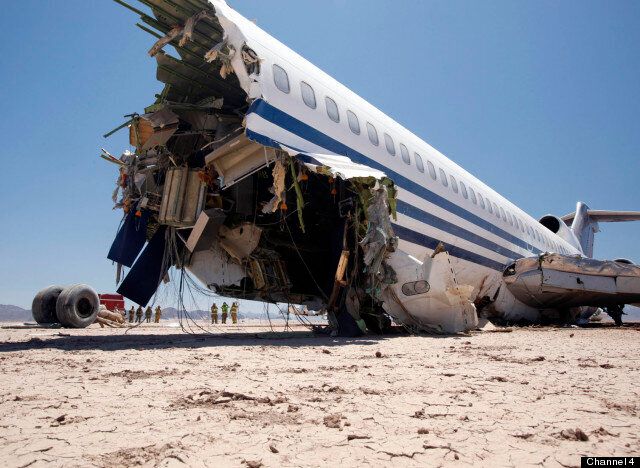A plane crash is most people's worst nightmare.
But for Sanjay Singhal, watching a Boeing 727 smash into the Mexican desert will signal the completion of a four year project to stage a controlled plane crash.
His documentary follows a team of scientists, experts and pilots as they deliberately crash-land a passenger jet.

The nose of the plane crumpling as the plane crashes. The pilots all parachuted off the plane before the crash
"It's a phenomenally expensive and dangerous thing to do," said Singhal, executive producer of The Plane Crash
"It has only been done once before by Nasa in 1987. They were testing a fuel additive to help restrict the risk of fire. On that test they lost control of the plane and the whole aircraft turned into a fireball."
The programme invites viewers to "check in online" prior to the programme and see how they would fare in the seat they picked.

The dramatic wreckage of the plane, with wires and seats hanging out the gigantic craft
Although it has been labelled a 'macabre' exercise by some, Singhal told the Huffington Post UK the project was "absolutely not about scaremongering."
Instead he described it as a "incredible opportunity" to explore the exact mechanics of a plane crash and see how passengers can improve their chances if the unthinkable did happen.
"I was intrigued to see what could be learnt in terms of plane safety by crashing it under controlled conditions."
"Scientists do it a lot with cars but not with planes," he said.

Almost Ozimandian, the wheels stand separate and intact, away from the mauled plane
There's good reason for that.
Singhal describes how difficult it was to find the right team of people and then to find a location.
Even once they had secured permission from the Mexican authorities, they only had a small time window and weather conditions were against them.
The pilots had to parachute out of the plane before the crash, making the high winds another risk factor.
"Getting insurance was nightmare as there was extraordinary risk involved" Singhal said.

Over 400 tonnes of metal and burning rubber crashed in the Mexican desert
Although the dramatic pictures may suggest otherwise, Singhal said the results were both "reassuring and surprising."
"It was good to see how advancements have massively improved the safety of passengers over the last 20 years.
"I also didn't realise how important the brace position was or the risks associated with it.
"For example you can break your legs in the brace position as all your weight is moved forward, but dummies in the unbraced position would have had potentially serious head injuries "
He also said it was interesting to see which parts of the plane offered the best chances of survival in this particular type of crash. Sitting at the back was the safest part of the plane, while passengers at the front, the pilot and the crew would most likely have been killed.